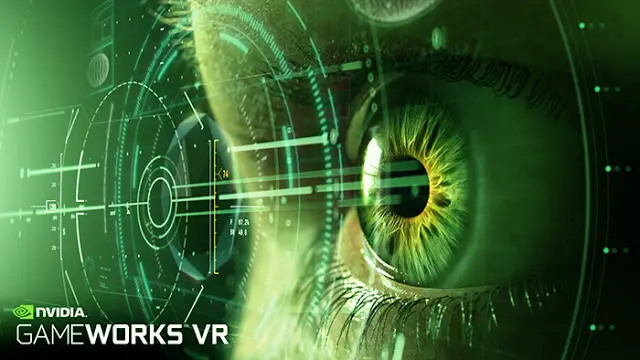 |
| (Source from NVIDIA: http://goo.gl/1rfF1y ) |
Virtual reality is among the most compelling advances in next-generation gaming, providing full immersion in a virtual world. But delivering a great VR experience requires serious computing power.
That’s why NVIDIA announced the GeForce GTX 980 Ti — their new flagship GPU. Along with it, NVIDIA has also announced a new software development kit, GameWorks VR, to help VR headset and game developers build incredible experiences on GeForce GPUs.
This kind of technology is needed now more than ever.
In May, Oculus recommended that gamers run a GeForce GTX 970 or higher GPU for the optimal experience with the upcoming Rift VR headset. It’s no easy feat to drive stereo gaming on a high-resolution 2160×1200 display at 90Hz, with near-zero tolerance for latency or stutter.
To deliver that, GameWorks VR combines features announced back at GDC 2015 under the banner of VR Direct with new and enhanced capabilities.
GameWorks VR includes:
- NVIDIA Multi-Res Shading (MRS) — An innovative new rendering technique for VR. With NVIDIA MRS, each part of an image is rendered at a resolution that better matches the pixel density of the final displayed VR image. This technology uses the multi-projection architecture of the GeForce GTX 980 Ti GPU to render multiple viewports in a single pass. The result: substantial performance improvements for VR games.
- VR SLI — Provides increased performance for VR apps. Multiple GPUs can be assigned a specific eye to dramatically accelerate stereo rendering. With the GPU affinity application programming interface, VR SLI allows scaling for PCs with two or more GPUs.
- Context Priority — Enables control over GPU scheduling to support advanced VR features such as asynchronous time warp. This cuts latency and quickly adjusts images as gamers move their heads, without the need to re-render a new frame.
- Direct Mode — Delivers plug-and-play compatibility for VR headsets. With Direct Mode, the NVIDIA graphics driver recognizes the headset as a VR display rather than a standard desktop monitor, providing a more seamless user experience.
- Front Buffer Rendering — Lets the GPU to render directly to the front buffer to reduce latency.
- An alpha version of the GameWorks VR SDK is already in the hands of – and receiving positive feedback from — VR industry leaders such as CCP Games, Epic Games, HTC, Oculus, and Valve. If you’re a VR developer interested in receiving the SDK, check out our GameWorks VR developer page.
VR is coming. If you have seen any of the stunning demos like Thief in the Shadows, Back to Dinosaur Island, EVE: Valkyrie or the HTC Vive demos, you know this is going to be a wild ride. Happy gaming.








